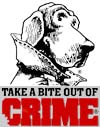|

|
Crime Prevention and Awareness
|
|
Vehicle
Safety Awareness Tips Common Sense - An unlocked vehicle with a
key in the ignition is an open invitation to any thief. The common sense approach to protection is the simplest and most cost-effective
way to thwart would-be thieves. Secure your vehicle, even if parked for brief periods. You should always: 1) Remove your keys from the ignition. 2) Lock your doors and close your windows. 3) Park in well lit areas. Warning Devices - The second layer
of protection is a visible or audible device which alerts thieves that your vehicle is protected. Popular second layer devices
include: 1) Audible alarms. 2) Steering column collars. 3) Steering wheel/brake pedal locks. 4) Wheel locks. 5)
Theft deterrent decals. 6) Identification markers in or on vehicle. 7)
VIN etching. Immobilization Device - The third layer of protection is a device
which prevents thieves from bypassing your ignition and hot-wiring the vehicle. Some vehicles have computer chips in the ignition
key. Other devices inhibit the flow of electricity or fuel to the engine until a hidden switch or button is activated. Popular
third layer devices include: 1) Smart keys. 2) Kill switches. 3) Starter, ignition and fuel pump disabelers. Tracking Devices - The
final layer of protection is tracking devices, which emit a signal to Police or a monitoring station when the vehicle is stolen.
Tracking devices are very effective in helping authorities recover stolen vehicles.
|
|

|
Talking
to Kids About Drugs
|
Don't put off talking to your children about alcohol and other drugs. As early as fourth
grade, kids worry about pressures to try drugs. School programs alone aren't enough. Parents must become involved, but most
parents aren't sure how to tell their children about drugs. Open communications are one of the most effective tools you can
use in helping your child avoid drug use. Talking freely and really listening shows children that they mean a great deal to
you. What Do You Say? - Tell them that you love
them and you want them to be healthy and happy.
- Say you do not find alcohol and other illegal
drugs acceptable.
- Many parents never state this simple principal. Explain how this use hurts
people. Physical harm - for example, AIDS, slowed growth, impaired coordination, accidents. Emotional harm - sense of not
belonging, isolation, paranoia. Educational harm - difficulties remembering and paying attention.
- Discuss
the legal issues. A conviction for a drug offense can lead to time in prison or cost someone a job, a driver's license, or
a college loan.
- Talk about positive drug-free alternatives, and how you can explore them
together. Some ideas include sports, reading, movies, bike rides, hikes, camping, cooking, games, and concerts. Involve your
kids friends.
How Do You Say It? - Calmly
and openly - Don't exaggerate. The facts speak for themselves.
- Face to face - exchange information
and try to understand each other's point of view. Be an active listener and let your child talk about fears and concerns.
Don't interrupt and don't preach.
- Through "teachable moments" - in contrast to
formal lectures, use a variety of situations - television news, TV dramas, books, newspapers.
- Establish
an ongoing conversation rather than giving a one-time speech.
- Remember that YOU SET
THE EXAMPLE. Avoid contradictions between your words and your actions. AND DON'T USE ILLEGAL DRUGS, PERIOD!
- Be creative! You and your child might act out various situations in which one person tries to pressure another
to take a drug. Figure out two or three ways to handle each situation and talk about which works best. Exchange ideas
with other parents.
How Can I Tell If A Child Is Using Drugs? Identifying illegal drug use may help prevent further abuse. Possible signs include: - Change in moods - more irritable, secretive, withdrawn, overly sensitive, inappropriately angry, euphoric.
- Less responsible - late coming home, late for school or class, dishonest.
- Changing
friends or changing lifestyles - new interests, unexplained cash.
- Physical deterioration
- difficulty in concentrating, loss of coordination, loss of weight, unhealthy appearance.
Why Do Kids Do Drugs? Young people say they turn to alcohol and other drugs for one
or more of the following reasons: - To do what their friends are doing
- To escape pain in their lives
- To fit in
- Boredom
- For fun
- Curiosity
- To take risks
Take A Stand! - Educate yourself about the facts surrounding alcohol
and other drug use. You will lose credibility with your child if your information is not correct.
- Establish
clear family rules against drug use and enforce them consistently.
- Develope your parenting
skills through seminars, networking with other parents, reading, counseeling, and support groups. Work with other parents
to set community standards - you don't raise a child alone.
- Volunteer at schools, youth
centers, Boys & Girls Clubs, or other activities in your community.
For
More Information Contact: National Clearinghouse for Alcohol and Drug Information
(NCADI) P.O. Box 2345 Rockville, MD 20847-2345 800-729-6686 or 301-468-2600 FAX 301-468-6433
|
|

|

|